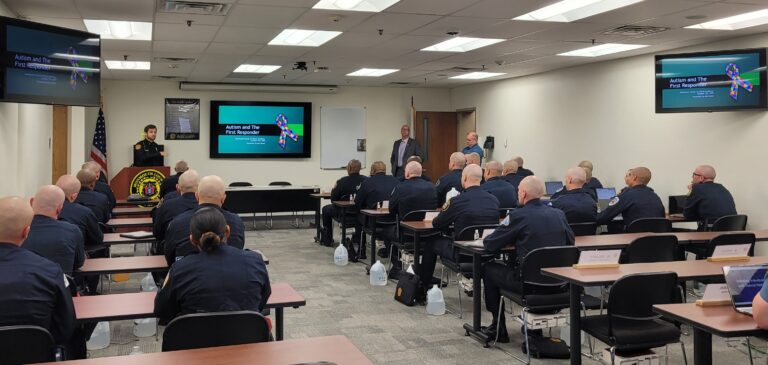
Training is an essential component of any occupation, especially when safety is a consideration. Police officers receive a significant amount of training on a wide array of topics, including Police Academy recruit training and in-service training, whether elective or mandated. In any profession, it is often the quality and substance of that training that will determine how that trainee responds to a given scenario within their field. Law enforcement is called upon to make split-second decisions. Success and the avoidance of professional missteps, or even worse, tragedy, are largely dependent upon effective training.
Why Is Autism Training for Law Enforcement Needed?
Pursuing a proactive approach to effective autism training, coupled with the practice of patience and tolerance, will ensure the well-being of the autism community, the public, and law enforcement. We are not asking law enforcement to function as clinicians or to diagnose an individual they encounter in the moment as doing so is far beyond the scope of law enforcement. Rather, training provides another tool for law enforcement to respond to a given situation and ensure that de-escalation techniques are employed to ensure a safe and positive interaction. Moreover, high quality training permits an officer to reduce potential liability and the unwarranted or unnecessary use of force.
Autism’s Prevalence in the US | According to the Centers for Disease Control (CDC), autism is the fastest growing developmental disability worldwide. Read more
New Jersey’s Training Mandate | State law requires New Jersey law enforcement to be trained regarding interactions with persons with autism and developmental disabilities. Read more
In compliance with the 2008 law requiring police personnel receive autism and developmental disability training, the State offers several video training options through NJ LEARN, and the New Jersey Office of Attorney General-mandated Integrating Communication Assessment Tactics (ICAT) training and the Community-Law Enforcement Affirmative Relations (CLEAR) Institute. Many county law enforcement-led in-person Crisis Intervention Team trainings, primarily instructing on interactions with those diagnosed with mental illness, now include instructional blocs on autism and developmental disabilities. Moreover, multiple Police Academies in the State of New Jersey offer recruits training on safe interactions with the autism community. There are also numerous law enforcement-led and private vendor in-service autism trainings available for law enforcement and other first responders throughout the state.
Additionally, the New Jersey Office of the Attorney General, in conjunction with its partners at the Department of Health, will be disseminating law enforcement guidance regarding S761 (“Requires MVC to provide, upon request, notation on driver’s license or identification card of diagnosis of autism spectrum disorder or communication disorder”) which, as its title states, requires the Motor Vehicle Commission to, “provide, upon request, notation on driver’s license or identification card of diagnosis of autism spectrum disorder or communication disorder.” This law, voluntary in nature, will go into effect in December 2024.
Encounters Between Autistic Individuals and Law Enforcement: Background | It is often noted that autistic individuals are seven times more likely to encounter law enforcement professionals than their neurotypical peers. Read more
“Although individuals on the autism spectrum are not at a higher risk of offending compared to the general population, they are reported to be coming into contact with police personnel at disproportionate rates. Autistic persons are more likely to be stopped and questioned by police than they are to be arrested or convicted of an offense.”
Rava, J., Shattuck. P., Rast., & Roux, A. (2017). The prevalence and correlates of involvement in the criminal justice system among youth on the autism spectrum. Journal of Autism and Developmental Disorders, 47(2), 340–346.
Encounters Between Autistic Individuals and Law Enforcement: Challenges | Contact between the autism and law enforcement communities can take various forms, including routine motor vehicle stops, targeted stops and questioning based upon perceived suspicious behavior, missing persons or elopement, public disturbance calls, and victim or suspect scenarios. Read more
“Having an encounter with police…is an unsettling encounter for anybody, but for someone with autism, it can be extremely distressing.” Helen Lyons, Metropolitan Police Detective Superintendent, Adults Neglected, Vulnerable and Abused Division. To the untrained law enforcement professional, common autism characteristics such as communication difficulties, lack of eye contact, pacing or fidgeting, stimming or repetitive behaviors, emotional dysregulation, delay in responses and high levels of anxiety and agitation may be misinterpreted as suspicious and criminally avoidant behavior such as failure to comply with commands. These types of behavioral displays may also be misperceived as signs of alcohol or substance abuse. Having a negative first encounter with law enforcement may lead to heightened anxiety and an avoidance in self-reporting an autism diagnosis in future encounters. Such a pattern may lead to unwanted and even dangerous outcomes for both the law enforcement and autism communities.
Quality Indicators for Effective Law Enforcement Autism Training
Recommended Length
To incorporate all the essential and recommended elements below, a comprehensive training will often need to be several hours in length. However, we recognize this may not always be feasible and therefore we recommend focusing on the most essential elements to maximize whatever time is available for training.
Recommended Format
Generally speaking, in-person training will often resonate more deeply with trainees and provide a sufficient baseline of instruction to be supplemented with future in-service live or virtual trainings. Again, however, this may not always be feasible. When in-person trainings are not possible it is recommended that:
- Virtual trainings be held live (synchronous) OR
- Prerecorded trainings (asynchronous) embed components that encourage active responding and engagement OR
- Departments supplement prerecorded trainings with moments for active engagement and discussion
Recommended Components of Training
What should someone look for in a quality autism training? The answer to this question can be divided into essential and additional elements. Law enforcement is inundated with training, and due to budgetary and overtime considerations, not all departments will have the capacity to engage in some of the recommended criteria. Here are some considerations.
Essential Elements
Curriculum
- An overview of autism, behavioral characteristics, communication strategies (including use of communication supports and tools for non or minimally verbal individuals), and co-occurring disorders
- An overview of existing autism-friendly practices such as registries, Blue Envelope, autism car decals and magnets, autistic passenger seatbelt covers
- Considerations with wandering, elopement, and real-time locative devices
- Strategies for effective in-the-moment interactions including recognition of potential signs of autism in the moment, reduction of extraneous sensory stimuli (lights and sirens), and accommodations for boundaries and personal space needs
- Techniques for de-escalation including remaining calm and patient, speaking clearly and concisely, and allowing for additional response time
- Use of force considerations
- An overview of autism-specific laws and guidance documents (e.g., NJ S761- “Requires MVC to provide, upon request, notation on driver’s license or identification card of diagnosis of autism spectrum disorder or communication disorder”)
Instructional/Learning Practices
- Training delivered by an individual with significant knowledge of autism and law enforcement – individuals without clinical and/or law enforcement backgrounds should obtain input and/or review from relevant professionals as appropriate to ensure the quality and accuracy of the training
- Discussion on both what to do and what NOT to do in given scenarios
- Active participation from trainees to allow for a free exchange of ideas and brief practice scenarios
- Follow up/refresher training on a periodic basis
Evaluation Measures
- Evaluation and feedback by attendees to allow for responsive and ever-improving trainings
Additional Elements
Curriculum
- Content reviewed by a reputable autism organization
- Discussion of considerations for police dispatchers
Instructional/Learning Practices
- Training delivered by a law enforcement professional jointly with a trained/licensed clinician often useful because the characteristics of autism are varied and may present differently across the spectrum
- Involvement of an autistic individual and/or autism community engagement
- Presentation of in-the-moment-scenarios and vignettes to be considered as a table-top exercise or in break-out groups with opportunities for review and discussion of the potential responses in given scenarios with feedback/critique from trainer(s)
- Role playing with “actors” to simulate in-the-moment scenarios, capitalizing on the general increased effectiveness of role-playing vs. lecture-based training
- Use of headset simulators to allow officers to experience situations from the autistic person’s perspective
Evaluation Measures
- Methodology for gathering measurable outcomes to determine the training’s effectiveness on performance in real world settings
Potential Funding for Training
While some in-service training opportunities are free of cost, if a municipal police department’s or county law enforcement office’s operational budget is insufficient to absorb the cost of private vendor training, alternative funding options are available. These include use of Law Enforcement Trust Account (LETA), Municipal Law Enforcement Trust Account (MLETA) and Special Law Enforcement Fund (SLEF) monies, generally comprised of monies forfeited due to criminal activity. While there are several restrictions on the use of such monies, the training of law enforcement has almost always been deemed the legitimate and primary use of these funds. Law enforcement agencies can also pursue appropriate state or federal grant funding offerings or make application for dedication of American Rescue Plan Act (ARPA) monies to a law enforcement training program.
Finding a Training
For information about in and out-of-state offerings, visit our referral database. If you are unsuccessful with finding a trainer in our referral database, call our 800.4.AUTISM Helpline or email us at: information@autismnj.org.








